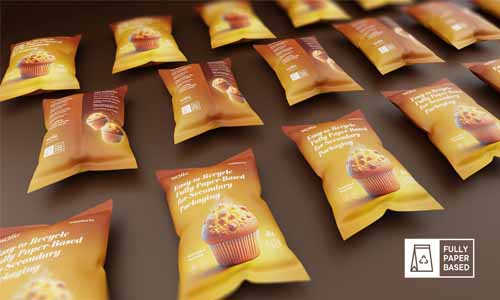
Many brand owners want to make the switch from plastic-based packaging to a fibre-based alternative. A fast path towards reducing the use of plastics in packaging is to focus on secondary packaging made of paper, protecting individually packed food stuff such as cookies, pancakes and cereal bars in a way that offers an attractive shelf-appearance.
The requirements on the material are a bit different for secondary packaging compared to primary packaging that comes in direct contact with the food content.
“Typically, you don’t have to worry about additional barrier functionality for secondary packaging as it does not need to protect the food product from moist and vapour, which is why film is usually the go to option for many primary packaging solutions. What is important from a mechanical point of view is that the paper is strong and stable enough to withstand the weight of the individual packages it has inside”, explains Andreas Rothschink, Head of Product Development & Technical Service, Consumer Packaging at Walki.
“As the main purpose of the secondary packaging is to keep the individual products safely inside, you need to make sure the pouch is well sealed”, adds Rothschink.
This can be done in two ways. You can either use a coated paper that has a very thin layer of coating on the whole surface. Another way is to use a partial coverage of the sealing medium on the areas where the package is sealed together.
“This enhances recyclability as you use considerably less sealing medium compared to full coverage of the paper material”, says Rothschink.
No matter which way you choose, both solutions offer excellent recyclability in the well-established paper waste stream.
Flexible and fast production
Another advantage of Walki’s secondary flexible packaging is that the seams of the packaging become sealable already in fairly low temperatures without compromising packing speed.
“This makes our solutions suitable for most of the packaging lines, including high-speed lines and contrary to what many believe, the production is not slower with fibre-based materials compared to film”, says Jani Avellan, R&D Director, Innovation at Walki, adding that Walki can apply sealing medium on different surfaces.
“We can do it on thin or thick paper, bleached or brown. We tailor-make the material to suit our customers’ demands.”
The brand owner values functionality, recyclability and an outstanding visual appearance to ensure that its products stand out on supermarket shelves.
“The current consumer trends show a preference for brown paper with a matte surface to demonstrate the sustainability of the packaging material”, says Andreas Rothschink.
The aesthetic demands on secondary packaging sets high requirements on printability. To satisfy all customer needs, Walki has recently invested in modern printing capacity and offers water-based inks and varnishes out of its plants in Poland, Finland and Germany.

































